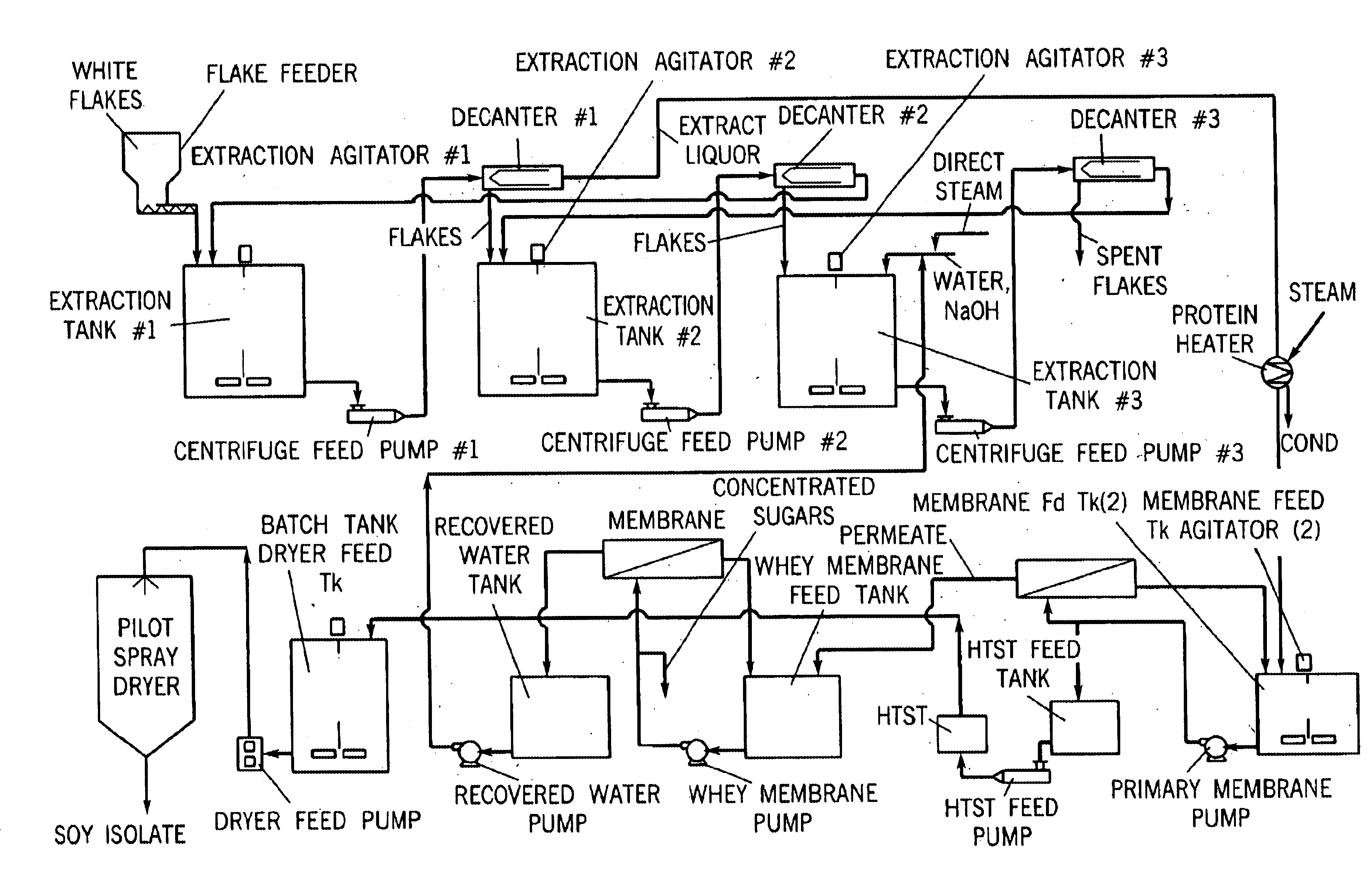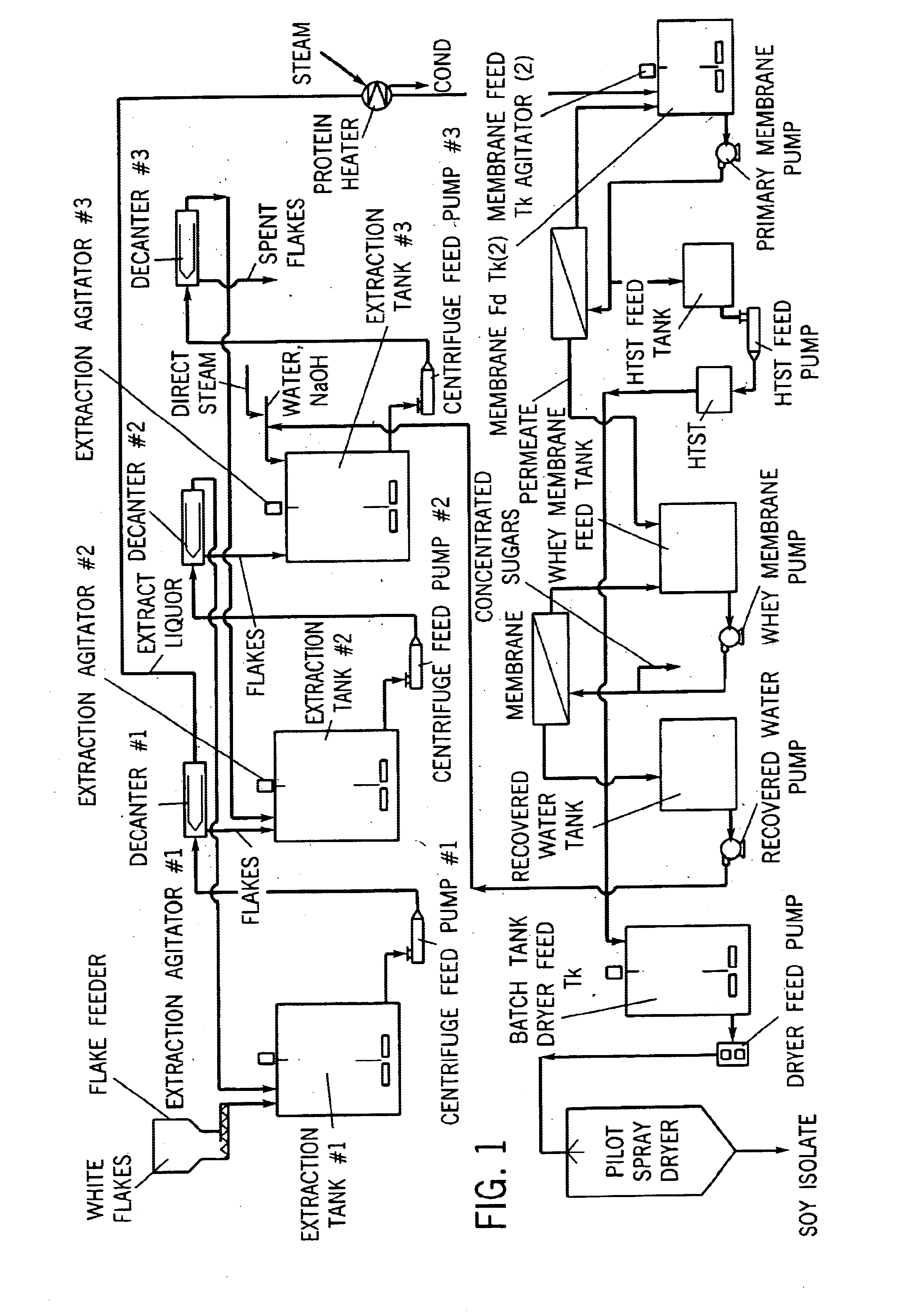Modified oilseed material
a technology of modified oilseeds and modified soybeans, applied in the field of modified oilseed materials, can solve the problems of affecting the functionality of the product, affecting the taste of the product, and affecting the nutritional quality of the product, so as to achieve the effect of viscosity
- Summary
- Abstract
- Description
- Claims
- Application Information
AI Technical Summary
Benefits of technology
Problems solved by technology
Method used
Image
Examples
example 1
[0102]Extractions were carried out batchwise in a 50 gallon stainless steel tank. This batch size utilized 30 lbs of white flakes and 30 gallons of water. This allowed the extract batch to be extracted and centrifuged in no more than about 2 hours with laboratory scale equipment. The amount of bacteria growth which occurs during the extraction operation can be minimized by limiting the amount of time needed to carry out the extraction and centrifugation operations.
[0103]The extraction tank, centrifuge, centrifuge filter cloth and all utensils were sanitized with hot water and sodium hypochlorite (NaOCl) prior to use. City water (28.8 gal) at 80° F. (27° C.) was introduced into the extraction tank. After the extraction tank agitator was started, 30 lbs of soy white flakes were introduced into the extraction tank. The pH of the resulting slurry was adjusted by adding a solution of 92 grams of sodium hydroxide dissolved in 400 mL city water. The slurry was then stirred at room temperat...
example 2
[0112]Batches (30 lbs) of soy white flakes were extracted and processed according to the procedure in Example 1 except that after pH adjustment (to pH 6.8-7.0) the retenate was not subjected to HTST treatment. Instead, following pH adjustment, the retenate was spray dried using the procedure described in Example 1 to yield a soy protein product. The spray dried soy protein product had an average particle size of about 20 microns and a total bacterial count of no more than about 50,000 cfu / g.
example 3
[0113]Batches (30 lbs) of soy white flakes were extracted and processed according to the procedure described in Example 1. At the beginning of the extraction the pH of the resulting slurry was adjusted by adding a solution of 165 grams of sodium hydroxide dissolved in 1,000 mL city water. The initial pH of the aqueous phase of the slurry was about 9.8 and after stirring for 30 minutes, the pH of the extract was about 9.5. After pH adjustment (to pH 6.8-7.0), the retentate was subjected to treatment at a relatively high temperature for a short time (“HTST”) in order to pasteurize the retentate using the procedure described in Example 1. The HTST treated material was then spray dried using the procedure described in Example 1 to yield a soy protein product. The spray dried soy protein product had an average particle size of about 20 microns, contained circa 88-89 wt. % protein (dry solids basis) and had a water content of about 8-9 wt. %.
PUM
 Login to View More
Login to View More Abstract
Description
Claims
Application Information
 Login to View More
Login to View More - R&D
- Intellectual Property
- Life Sciences
- Materials
- Tech Scout
- Unparalleled Data Quality
- Higher Quality Content
- 60% Fewer Hallucinations
Browse by: Latest US Patents, China's latest patents, Technical Efficacy Thesaurus, Application Domain, Technology Topic, Popular Technical Reports.
© 2025 PatSnap. All rights reserved.Legal|Privacy policy|Modern Slavery Act Transparency Statement|Sitemap|About US| Contact US: help@patsnap.com



